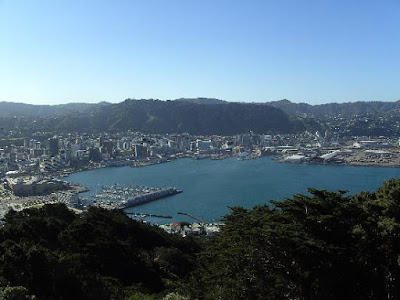This article appeared in the Dominion Post’s Wellington Essay series in December 2007. It makes me think of summer.
Nothing stays the same on Mount Victoria. The pines through which I walk with my son weren’t here in 1930 and won’t be here in 2030. On one side of the Mount Victoria ridge, the Basin Reserve used to be a swamp. On the other, Miramar used to be an island. Film crews come and go. Mountain bikes race by. Tracks narrow or widen, appear or disappear.
But things stay the same long enough that I have been walking these tracks for more than twenty years, and I hope to walk them for many more years yet. When I still lived in Dunedin, I used to visit Wellington several times a year, and stay with a friend who lived in Hataitai. Young, fit, and skint, I chose to walk over the hill into town rather than take the bus. From the heights of Mount Victoria, I began to get a sense of how Wellington was put together.
In 1993, I moved to Wellington to be with Kay, who owned a house high on the slopes of Mount Victoria. I had been a tramper down south, taking off with friends during the Christmas holidays for a week of sandflies, speargrass, and sensational views in and around the Southern Alps. Despite my best intentions, I did not take up tramping again after I moved to Wellington; but I did get very familiar with the track network that runs from the coast at Oriental Bay, around the flanks of Mount Victoria, and south past Wellington Zoo towards Island Bay.
Our son was born in 1996. By the time he was eighteen months old, I was taking him with me to the lower slopes of Mount Victoria, next to the quarry at the top of Ellice Street. I’d carry him in my arms, then put him down carefully on a level section of track to watch him waddle in front of me until he either sat down with a well-cushioned bump or called for me to pick him up.
By the time he was four, we were venturing well off into the distance, even making it all the way to the Mount Victoria lookout on one memorable occasion. (Memorable, but tiring – I carried him much of the way back.) We came up with our own names for the tracks, like the Ball and Sport Track, so-called because a tennis ball placed at the top would roll straight down it, and sport is where you use balls. I think he came up with that one.
He attended Hataitai Kindergarten and then Kilbirnie School. When I was working from home, I’d drag myself away from my computer at 2.45pm and slog over the hill to get him, then we’d walk back at a more leisurely pace.
The view from above the pines of Mount Victoria
Changes followed us down the years. When we started, the forest airspace was ruled by magpies. Since then, they have been challenged and largely supplanted by the equally aggressive but much more lovable tui, colonists from Karori. We witnessed the unchecked proliferation of the mountain bike, and learned to listen hard when walking along narrow tracks with no easy stepping-off places for the sudden whir of wheels.
Our path to Kilbirnie School went up and to the right of the quarry at the top of Ellice Street which is now immortalised in both The Fellowship Of The Ring and The Return Of The King. Anorak time: in Fellowship, there’s a brief shot, taken from above, of the Black Riders approaching Weathertop. The ground they are crossing is the grassed quarry floor, with some added vegetation brought in for the filming.
More famously, in Return, the quarry is the setting for the muster of the Rohirrim before they ride off to the aid of Gondor. Elrond bears the sword Andúril to Aragorn there, and when Aragorn, Legolas, and Gimli set off to walk the Paths of the Dead, they do so through a narrow chasm created in the back wall of the quarry by the magic of CGI.
By special permission, the film-makers were allowed to dig a trench in the quarry floor. My son and I looked at it, wondering what it was doing there and where it led. It was not until we watched Return that we learned it was the beginnings of a track the Riders of Rohan rode down on their way to Gondor.
A few days after the trench was dug, as we descended past the quarry on our way home from my son’s school, a friendly security guard let us stay and watch Théoden and Aragorn stare out from the quarry over the Muster of Rohan and decide that six thousand spears left them a mite short-handed.
Where is the horse and the rider? Where is the helm and the hauberk, and the bright hair flowing? The trench the Riders rode down was filled in soon after filming finished, and only a careful eye can see the faint depression it has left in the restored earth of the quarry floor.
After the Ring left Mount Victoria, the next peak of excitement was the arrival of the Wood Weta. As part of its plan to revegetate the Town Belt with native plants, and to reduce danger from windfall, the City Council decided to cut down the mature pines that dominated the slopes above the old Chest Hospital where my mother-in-law had once been a nurse. The Wood Weta was brought in to deal with the twigs and small branches left behind when the chainsaws fell silent. My son and I sat at one end of Alexandra Park and watched the monster wood chipper chomp its way through the detritus at the other.
In the long term, all the pines will be gone, and native forest will once again cloak the flanks of Matairangi. On an intellectual level, I’m in complete agreement with this plan. But, if I live long enough to see the process complete, part of me will miss the pines. The soughing of the north-westerly through their branches, audible from our back deck on windy nights; the roots setting traps for the unwary walker; even the risk of having one’s head split open by a falling pinecone or a falling branch on windy days: I’ll miss them all. But if the native bush returns, and the pests are kept at bay, the birds will return also. Mount Victoria may never reproduce the wall of sound that is the dawn chorus on Kapiti, but the tui have whetted my appetite for more.
Nothing stays the same on Mount Victoria. The mountain itself will be dust one day. But while I can, I’ll keep on striding those narrow, root-riddled tracks, dodging the mountain bikes, listening to the tui, walking above the city and under the sun.
